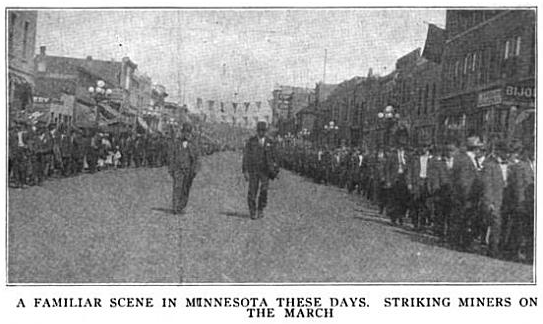There are no limits to which
powers of privilege will not go
to keep the workers in slavery.
-Mother Jones
Hellraisers Journal, Wednesday August 30, 1916
Mesabi Range, Minnesota – “A Fierce and Important Struggle”
From The Outlook: Report of Mary Heaton Vorse, Part I:
THE MINING STRIKE IN MINNESOTA
-FROM THE MINERS’ POINT OF VIEWSPECIAL CORRESPONDENCE OF THE OUTLOOK
ONE of the most sinister aspects of life in this country is the failure of the serious and thinking people to obtain prompt information about the various industrial struggles and to get at the causes which are at the root of our industrial unrest.
Since June 3 a strike has been waged on the Mesaba Range, Minnesota, whose largest single owner is the Oliver Iron Mining Company, an arm of the Steel Trust. This strike has affected the life, not only of the twelve thousand miners employed on the Range, but of ten towns and villages from Aurora to Hibbing, a distance of sixty miles. The strike has been characterized by the prompt deputizing of a large force of gunmen, numbering, according to Sheriff J. R. Meining, of Duluth, over a thousand; more, according to residents of the Range towns.
And although this strike has aroused the bitterest feeling on both sides, although it has affected directly and indirectly thousands of people, although there have been three people killed, several wounded, and over two hundred arrested and six held for murder (Carlo Tresca and seven other organizers were held on the charge of being accessory before the act), there has appeared in the public press only a brief paragraph or two—nothing that would give any picture of the magnitude of this struggle.
According to George P. West, of the Committee on Industrial Relations, “the city of Duluth, the county of St. Louis, and the State of Minnesota as represented by Governor Burnquist and other public officials have joined hands in a relentless effort to crush the strike of the iron-workers.” He goes on to say: “With the support and good will of the United States Steel Corporation and affiliated interests in the State, Governor Burnquist, Sheriff John R. Meining, of Duluth, County Prosecutor Greene, and the Duluth Chief of Police are playing at ducks and drakes with the most sacred rights of the foreign workmen who mine the ore that goes down to the ships at Duluth for shipment to the Pittsburgh Mills.”
That this fierce and important struggle should have gone on so long without arousing comment is the direct fault of no one. It is not due to any consciously willful suppression of the news. It is due rather to the lack of communication between the workers and that thinking part of the community which forms the public opinion which asks that labor shall receive its fair hearing in the courts and in the press.
On the 2d of June, 1916, a small mine, the St. James, in Aurora, a town of seven thousand inhabitants, situated at the extreme east of the Range, struck. At that time and until several days later there were no organizers of any kind on the Range.
The strike apparently had its origin in the losing of a beautiful hope. The miners on the Mesaba Range are paid in two different ways: the open-pit men by the day; some of the underground men who are not miners are also paid by the day, a system of payment known as “company count;” the underground miners are paid on a system of piece-work known as the contract system. On February 1 the wages of the open-pit miners were raised; on May 1 there was another raise which brought the price of this class of labor up to $2.60.
The company alleges that the wages of those working under the contract system were raised proportionately. Apparently the miners remained in ignorance of this raise, or it was in some way rendered inoperative, for they struck. In all the conversations that various investigators, including the Federal mediators, have had with the miners no miner seems to have known that his wages were raised. They proved how little they knew about it and how deeply they resented a series of injustices great and small which the contract system made possible by a spontaneous strike, which leaped down the Range as the forest fires which have devastated the great trees around the mines.
The demands made by the workers are as follows: $2.75 a day for open-pit mining; $3 a day for underground mining, dry work; $3.50 a day for underground mining, wet work; an eight-hour day; pay twice a month; abolition of the contract system.
The company asserts that only twenty-eight per cent of the underground workers—the real miners—are paid less than $3 a day, and that it would be unfair to the skillful miner to equalize the pay at his expense. The answer of the miners is that the contract system as practiced on the Mesaba Range makes wages so uncertain and leads to so much petty graft and unjust discrimination on the part of the shift bosses and captains that in the working out of the system they do not make $3 a day. So the paradoxical situation exists that, according to company figures, the miners are actually striking for a less wage than the majority receive.
[Photograph added.]
[Hellraisers will conclude the article tomorrow with Part II.]
~~~~~~~~~~~~~~~~~~~~~~
SOURCE
The Outlook, Volume 113
(New York, New York)
-May-August, 1916
Outlook Company, 1916
https://books.google.com/books?id=LUlYAAAAYAAJ
Outlook of August 30, 1916
https://books.google.com/books/reader?id=LUlYAAAAYAAJ&printsec=frontcover&output=reader&source=gbs_atb&pg=GBS.PA1015
“The Mining Strike in Minnesota,
from the Miners’ Point of View”
-by Mary Heaton Vorse
https://books.google.com/books/reader?id=LUlYAAAAYAAJ&printsec=frontcover&output=reader&source=gbs_atb&pg=GBS.PA1036
IMAGE
March, Mesabi, Marcy, ISR Aug 1916
https://books.google.com/books/reader?id=SVRIAAAAYAAJ&printsec=frontcover&output=reader&source=gbs_atb&pg=GBS.PA76
See also:
A Footnote to Folly:
Reminiscences of Mary Heaton Vorse
-by Mary Heaton Vorse
Farrar & Rinehart, 1935
Chp IX. Mesaba Range
https://books.google.com/books/about/A_footnote_to_folly.html?id=sKhAAQAAIAAJ
~~~~~~~~~~~~~~~~~~~~~~~~~~~~~~~~~~~~~~~~~~~~~
North Country Blues – Joan Baez
Lyrics by Bob Dylan
http://genius.com/Bob-dylan-north-country-blues-lyrics

